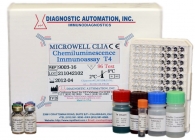
ELISA Kits
- • Anemia ELISA kits
- • Allergy ELISA kits
- • Autoimmune Disease kits
- • Bone Metabolism ELISA kits
- • Blood bank ELISA kits
- • Cancer ELISA kits
- • Cardiac Markers ELISA kits
- • Diabetes Assays ELISA kits
- • Drug test ELISA kits
- • Fertility ELISA kits
- • Food ELISA kits
- • Infectious Disease ELISA kits
- • Other ELISA Kits
- • Parasitology ELISA kits
- • Steroid ELISA kits
- • Thyroid ELISA kits
Rapid Tests
- • Allergy Rapid tests
- • Bone Metabolism
- • Cancer Rapid tests
- • Cardiac markers Rapid tests
- • Drug Tests
- • Fertility Rapid tests
- • Hepatitis Panel
- • Infectious Disease & other tests
- • Other
- • Ovulation Rapid tests
- • Pregnancy tests
- • Urine Reagent Strips tests
IFA Kits
Chemiluminescence Immuno Assays
- • Allergy Assays
- • Autoimmune Thyroid Assays
- • Cardio-Vascular Monitoring
- • Diabetes Assays
- • Fertility Assays
- • Growth Deficiency
- • Infectious Disease Assays
- • Others
- • Steroid Assays
- • Thyroid Assays
- • Tumor Marker Assays
Serology Tests
- • ASO (Anti-Streptolysin-O)
- • CRP (C-Reactive Protein)
- • Mono (Infectious Mononucleosis)
- • RF (Rheumatoid Factor)
- • RPR (Rapid Plasma Reagin)
- • SLE (Systemic Lupus Erythematosus)
Instrumentation



T4 CLIA kits - (Chemiluminescence Immuno Assay)
| Name |
T4 CLIA kits - (Chemiluminescence Immuno Assay) |
|---|---|
| Category Name | Thyroid Assays |
| Test | 96 |
 |
 |
 |
T4 CLIA kits - (Chemiluminescence Immuno Assay) description:
Chemiluminescence Immunoassay (CLIA) detection using Microplate luminometers provides a
sensitive, high throughput, and economical alternative to conventional colorimetric methodologies, such as Enzyme-linked immunosorbent assays (ELISA). ELISA employs a label enzyme and a colorimetric substrate to produce an amplified signal for antigen, haptens or antibody quantitation. This technique has been well established and considered as the technology of choice for a wide variety of applications in diagnostics, research, food testing, process quality assurance and quality control, and environmental testing. The most commonly used ELISA is based on colorimetric reactions of chromogenic substrates, (such as TMB) and label enzymes. Recently, a chemiluminescent immunoassay has been shown to be more sensitive than the conventional colorimetric method(s), and does not require long incubations or the addition of stopping reagents, as is the case in some colorimetric assays. Among various enzyme assays that employ lightemitting reactions, one of the most successful assays is the enhanced chemiluminescent immunoassay involving a horseradish peroxidase (HRP) labeled antibody or antigen and a mixture of chemiluminescent substrate, hydrogen peroxide, and enhancers. The CLIA Kits are designed to detect glow-based chemiluminescent reactions. The kits provide a broader dynamic assay range, superior low-end sensitivity, and a faster protocol than the conventional colorimetric methods. The series of the kits covers Thyroid panals, such as T3, T4, TSH, Hormone panels, such as hCG, LH, FSH, and other panals. They can be used to replace conventional colorimetric ELISA that have been widely used in many research and diagnostic applications. Furthermore, with the methodological advantages, Chemiluminescent immunoassay will play an important part in the Diagnostic and Research areas that ELISAs cannot do. The CLIA Kits have been validated on the MPL1 or MPL2 microplate luminometer from Berthold Detection System, Lus2 microplate luminometer from Anthos, Centro LB960 microplate luminometer from Berthold Technologies, and Platelumino From Stratec Biomedical Systems AG. We got acceptable results with all of those luminometers.
L-Thyroxine (T4) is a hormone that is synthesized and stored in the thyroid gland. Proteolytic cleavage
of follicular thyroglobulin releases T4 into the bloodstream. Greater than 99% of T4 is reversibly bound
to three plasma proteins in blood - thyroxine binding globulin (TBG) binds 70%, thyroxine binding prealbumin (TBPA) binds 20%, and albumin binds 10%. Approximately 0.03% of T4 is in the free,
unbound state in blood at any one time. Diseases affecting thyroid function may present a wide array of confusing symptoms. Measurement of total T4 by immunoassay is the most reliable and convenient screening test available to determine the presence of thyroid disorders in patients. Increased levels of T4 have been found in hyper-thyroidism due to Grave’s disease and Plummer’s disease and in acute and subacute thyroiditis. Low levels of T4 have been associated with congenital hypothyroidism, myxedema, chronic thryoiditis (Hashimoto’s disease), and with some genetic abnormalities.
In the T4 CLIA, a certain amount of anti-T4 antibody is coated on microtiter wells. A measured amount
of patient serum, and a constant amount of T4 conjugated with horseradish peroxidase are added to
the microtiter wells. During incubation, the anti-T4 antibody is bound to the second antibody on the
wells, and T4 and conjugated T4 compete for the limited binding sites on the anti-T4 antibody. After a
60 minutes incubation at room temperature, the wells are washed 5 times by wash solution to remove
unbound T4 conjugate. A solution of chemiluminescent substrate is then added and read relative light
units (RLU) in a Luminometer. The intensity of the emitting light is proportional to the amount of
enzyme present and is inversely related to the amount of unlabeled T4 in the sample. By reference to a
series of T4 standards assayed in the same way, the concentration of T4 in the unknown sample is
quantified.
Home > Chemiluminescence Immuno Assays > Thyroid Assays > T4 CLIA kits - (Chemiluminescence Immuno Assay)
ELISA kits - Rapid tests- Drug tests- Pregnancy test - IFA kits - CLIA assays - Serology tests - Instrumentation
©1992 Diagnostic Automation/Cortez Diagnostics Inc. All rights reserved.








